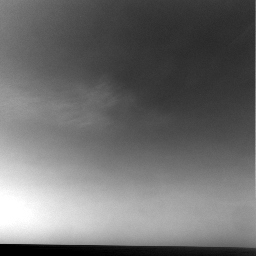
|
Martian Clouds Pass By on a Winter Afternoon
- Click the image above for a larger view
 Movie Download Options
Movie Download Options- Full-Res JPEG (512 x 512) (10.8 kB)
- Full-Res TIFF (512 x 512) (262.6 kB)
Caption:
NASA's Mars Exploration Rover Opportunity captured a view of wispy afternoon clouds, not unlike fair weather clouds on Earth, passing overhead on the rover's 956th sol, or Martian day (Oct. 2, 2006). With Opportunity facing northeast, the clouds appear to drift gently toward the west in this movie taken with the rover's navigation camera.
The 10 frames, taken 32 seconds apart, show the formation and evolution of what are likely mid-level, convective water clouds. Such clouds are common near Mars' equator at this time of the Martian year. They have been observed by both of NASA's Mars Exploration Rovers, by satellites orbiting Mars, and by the Hubble Space Telescope. In this case, the clouds appear to develop at a fixed location, in the center of the frame about 25 degrees above the horizon. This style of origin suggests that a thermal plume is rising over a surface feature. In spite of apparent winds aloft, the thermal plume appears to remain stationary for the 5-minute duration of the movie.
Though scientists have determined from the images that the wind bearing is east-northeast, approximately 80 degrees, it is not possible on the basis of the movie to unambiguously determine the height and speed of the clouds. Scientists estimate, based on models of atmospheric wind profiles and the apparent displacement of the clouds, that all of the clouds in the movie are at about the same height somewhere between 5 kilometers and 25 kilometers (3 to 20 miles) above the surface. The clouds are estimated to be moving at 2.5 meters per second, if they are low, to 12.5 meters per second, if they are high (8 feet per second to 41 feet per second).
Like clouds on Earth, these Martian clouds are probably composed of ice crystals and possibly supercooled water droplets. They are similar in appearance to terrestrial cirrocumulus or high altocumulus clouds. On Earth, such clouds are relatively transient and consist of small, individual cloudlets arranged in rippled patterns. They usually form 6 kilometers to 12 kilometers (4 to 7 miles) above Earth's surface by a process known as convection, during which warm air rises and cools, with clouds condensing from the moist air once it has cooled sufficiently.
These Martian clouds appear to be associated with a broader layer of ice-crystal clouds fanning out toward the upper right of the frames at the end of the movie. This is similar to the occurrence of terrestrial cirrocumulus and altocumulus clouds within layers of cirrus or cirrostratus clouds on Earth. Also apparent in this movie are prominent waves in the clouds, a result of the effect of gravity waves on cloud thickness, as on Earth.
Though both rovers now have the ability to autonomously detect clouds, these images were taken prior to the first use of the new abilities. The images shown here were stored on Opportunity and were transmitted to Earth on sol 1056 (Jan. 12, 2007) during a routine communications pass.
Cataloging Keywords:
| Name | Value | Additional Values |
|---|---|---|
| Target | Mars | |
| System | ||
| Target Type | Planet | |
| Mission | Mars Exploration Rover (MER) | Hubble Space Telescope (HST) |
| Instrument Host | Opportunity (MER-B) | Hubble Space Telescope |
| Host Type | Rover | Space Telescope |
| Instrument | Navigation Camera (Navcam) | |
| Detector | ||
| Extra Keywords | Atmosphere, Grayscale, Movie, Plume, Thermal, Water | |
| Acquisition Date | ||
| Release Date | 2007-01-29 | |
| Date in Caption | 2006-10-02 | 2007-01-12 |
| Image Credit | NASA/JPL/Texas A&M/Cornell | |
| Source | photojournal.jpl.nasa.gov/catalog/PIA09170 | |
| Identifier | PIA09170 | |
